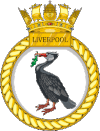HMS Liverpool (D92)

Liverpool off Cape Wrath, Scotland, August 1986
|
|
| History | |
|---|---|
|
|
|
| Name: | HMS Liverpool |
| Ordered: | 1 March 1977 |
| Builder: | Cammell Laird |
| Laid down: | 5 July 1978 |
| Launched: | 25 September 1980 |
| Sponsored by: | Lady Strathcona, wife of Euan Howard, 4th Baron Strathcona and Mount Royal |
| Commissioned: | 1 July 1982 |
| Decommissioned: | 30 March 2012 |
| Identification: | Pennant number D92 |
| Nickname(s): | "Crazy Red Chicken" |
| Fate: | Scrapped October 2014 |
| Badge: |  |
| General characteristics | |
| Class and type: | Type 42 destroyer |
| Displacement: | 4,820 t (4,740 long tons) |
| Length: | 125 m (410 ft) |
| Beam: | 14.3 m (47 ft) |
| Propulsion: |
|
| Speed: | 30 knots (56 km/h; 35 mph) |
| Complement: | 287 |
| Armament: |
|
| Aircraft carried: |
|
HMS Liverpool was a Type 42 destroyer of the Royal Navy. She was built by Cammell Laird in Birkenhead and launched on 25 September 1980 by Lady Strathcona, wife of Euan Howard, the then Minister of State for Defence. Liverpool was the last Type 42 Batch 2 in service.
Liverpool was taken up by the Royal Navy in April 1982 from Cammell Laird. After an accelerated trials period sailed for the South Atlantic in early June 1982. Though Liverpool did not see active service in the Falklands Conflict, she remained on station for the next six months before returning to the UK. In 1987 "Liverpool" was off the North coast of Russia monitoring and data collecting Soviet Naval missile and weapons firings. She then visited Holland. 1988 saw "Liverpool" undertake a DED in Rosyth, when she was fitted with the Phalanx weapons system. 1989 saw her deploy to the Persian Gulf for Operation ARMILLA, as she did again 1990. There then followed a period with the NATO Standing Force in the Mediterranean.
After the eruption of the Soufriere Hills Volcano in 1995, the destroyer played a vital role in the evacuation of Montserrations to nearby islands as part of an effort which saw 7,000 people leave the island for places such as Antigua and Barbuda (a 30-mile (48 km) distance, which was impossible by aircraft at the time due to the destruction of the Blackburne International airport).
Liverpool fired what is believed to be the first salvo of Sea Dart missiles in well over a decade, along with possibly the second only salvo ever. The firing took place approximately 250 miles (400 km) south-west of the Isles of Scilly on 8 September 2002, against a sea skimming target to demonstrate the effectiveness of the Sea Dart missile and Liverpool's systems following a 12-month refit at Rosyth Dockyard.
...
Wikipedia
